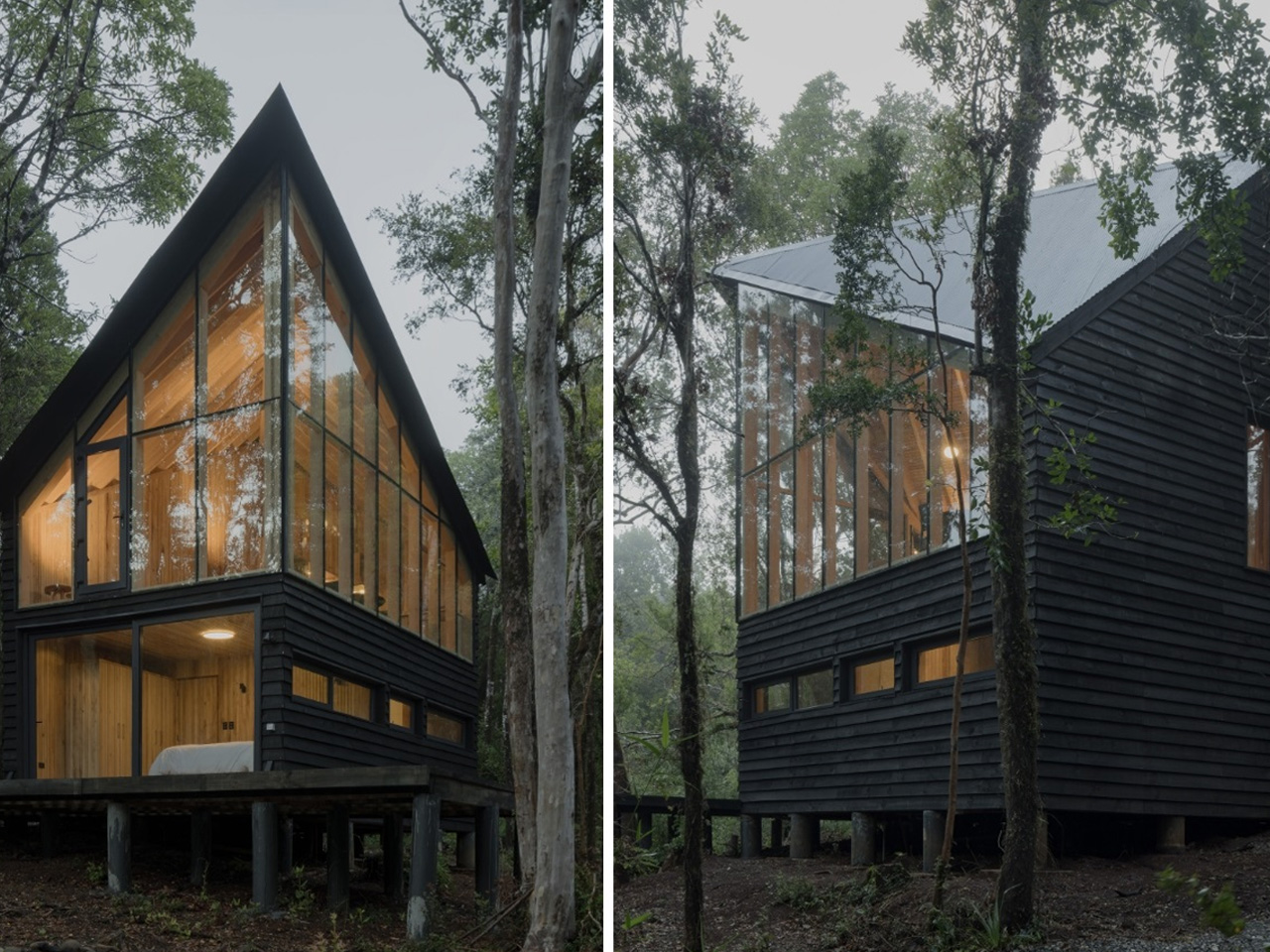Deep within Chile’s Valdivian rainforest, where ancient trees form cathedral-like canopies and humidity permeates every surface, Tomás de Iruarrizaga has designed something captivating. The Calfuco Refuge stands as a 50-square-meter testament to architectural restraint and environmental sensitivity. Positioned near Valdivia on the Pacific coast, this compact structure gives a whole new meaning to the concept of a holiday retreat. Its sharp, geometric form cuts through the organic chaos of the forest with surgical precision. The building functions as a sanctuary and statement, redefining what it means to inhabit such a delicate ecosystem.
Iruarrizaga conceived the refuge as a slender tower, a vertical prism that soars above the forest floor on concrete supports. This isn’t just aesthetic bravado—the elevated stance serves multiple functions with elegant efficiency. The angular geometry creates a stark dialogue with the rounded, organic forms surrounding it, establishing the structure as an intentional counterpoint to the natural world. The prismatic form maximizes interior volume while minimizing ground contact, preserving the forest’s integrity. Northern light floods the interior through carefully positioned openings, transforming the compact space into a luminous retreat.
Designer: Tomás de Iruarrizaga
The concrete pillar foundation system elevates the entire structure, creating a protective barrier against the region’s persistent moisture while reducing environmental impact. This ensures that the forest floor remains largely undisturbed, preserving natural drainage patterns and root systems. The minimal ground footprint allows the cabin to coexist with sensitive ecosystems without compromise. The supports anchor the building firmly while allowing it to float above the landscape like a geometric bird perched among the trees. Wind flows beneath the structure, preventing moisture accumulation and ensuring longevity in this humid climate.
Inside, laurel wood transforms the interior into a warm, tactile environment that contrasts beautifully with the building’s stark exterior. Every surface serves multiple purposes, echoing the efficiency found in yacht design, where space is precious and functionality paramount. Built-in furnishings maximize usable area while creating seamless transitions between different zones. The exposed wooden ribs and structural elements become decorative features, celebrating the construction process rather than hiding it. Natural light plays across the wood surfaces, creating an ever-changing interior atmosphere throughout the day.
The refuge unfolds across two precisely orchestrated levels, each serving different functions while maintaining spatial continuity. The ground floor houses essential private zones—a compact entry sequence that flows seamlessly into bedrooms and bathroom facilities, with stairs ascending like a sculptural spine.
This lower level forms cocoon-like spaces for retreat from the forest’s overwhelming sensory richness. The upper level transforms into the center of daily life, where the kitchen and living areas merge into a single, open expanse. Floor-to-ceiling windows frame the canopy at eye level, bringing inhabitants into direct dialogue with the treetops.
The refuge’s spatial organization is proof of exceptional planning within severe constraints. Each square meter works harder than in conventional buildings, with furniture that folds, surfaces that transform, and storage that integrates invisibly into walls and floors. The vertical orientation allows for distinct zones—sleeping, cooking, relaxing—while maintaining visual continuity throughout the space. Windows frame specific views of the surrounding forest, turning the landscape into a living artwork. The compact plan eliminates wasted circulation space, ensuring every inch contributes to the occupant’s experience.
The Calfuco Refuge is more than a successful holiday retreat; it creates new possibilities for sensitive site intervention. Iruarrizaga has shown us how contemporary architecture can respect environmental constraints while pushing formal boundaries. The vertical cabin serves as evidence that small-scale projects can carry profound architectural significance. Its influence extends beyond its modest footprint, offering lessons about restraint, functionality, and the poetry possible when form serves both human needs and ecological responsibility.
FAQs
1. What are the benefits of a vertical compact cabin for vacation retreats?
A vertical compact cabin offers a unique blend of efficiency and immersion in nature, making it ideal for vacation retreats. Its small footprint minimizes environmental impact, preserving the natural landscape while maximizing usable interior space. The vertical design allows for distinct living zones on separate levels, enhancing privacy and comfort. Elevated above the forest floor, these cabins often provide better views, increased natural light, and improved protection from moisture. The result is a retreat that feels spacious, sustainable, and deeply connected to its surroundings.
2. How does a vertical cabin design enhance the experience of staying in a forest or nature setting?
The vertical cabin’s design brings guests into direct dialogue with the forest canopy, offering panoramic views and a sense of elevation among the trees. Floor-to-ceiling windows and open-plan living spaces frame the surrounding landscape, turning nature into a living artwork. The compact, multi-level layout creates cozy, cocoon-like spaces for rest while maintaining openness in shared areas. This architectural style heightens the sensory experience of the forest—light, sound, and scenery—making each stay feel both intimate and extraordinary.
3. What should I consider when building or renting a vertical compact cabin for a getaway?
When building or renting a vertical compact cabin, consider factors like site sensitivity, material choices, and interior functionality. Look for designs that use sustainable materials and minimize ground disturbance, such as elevated concrete supports. Interior layouts should maximize space with built-in furnishings and multi-functional zones. Natural light, ventilation, and views are essential for comfort and ambiance. Finally, ensure the cabin’s location offers the tranquility and immersion in nature you seek for a memorable retreat experience.
The post Tiny Vertical Cabin In Chile’s Rainforest: The Ultimate Vacation Escape For Nature Lovers first appeared on Yanko Design.

